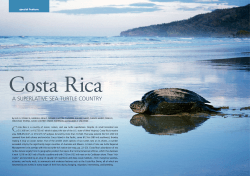
the secrets of sea Turtle Migrations in the southwest Indian Ocean
Revealing the Secrets of Sea Turtle Migrations in the Southwest Indian Ocean By Jérôme BOURJEA, Mayeul DALLEAU, and Stéphane CICCIONE S ea turtles do not recognize political boundaries, nor do they have regard for Exclusive Economic Zones (EEZs), cooperative agreements, international conventions, or memoranda of under- standing between countries. They don’t know the political and socioeconomic situation of the countries whose borders they cross nor the world economic crises that shape our human destiny. They migrate only to live. Tirelessly and mysteriously, they have migrated for millions of years between nesting sites and feeding grounds, sometimes swimming thousands of kilometers, passing through several countries and ecosystems, and interacting with human activities along the way—sometimes to their advantage but sometimes resulting in a premature end of their lives’ journeys. 10 | SWOT Report So it is in the Southwest Indian Ocean (SWIO). That region hosts some of the most important green turtle nesting sites in the world, most of which are isolated on remote islands (for example, at Europa [Îles Eparses, France], Aldabra and Cosmoledo [Seychelles], and Moheli [Union of the Comoros]). Nesting also occurs in significant numbers along the coasts of East Africa and Madagascar, which are better known for their vast seagrass pastures where green turtles graze. Mayotte (France), Grande Comoros, and Mauritius also have noteworthy foraging areas adjacent to their shores. However, very little is known about the migratory pathways that sea turtles ply between their nesting and feeding grounds—and even less is known about how they spend their time among the various countries in the SWIO. Adding to the migratory and spatial dynamics mysteries of SWIO turtles, recent studies show compelling genetic evidence (a) that green turtles nesting on the rookeries in the Southern Mozambique Channel belong to separate stocks from those nesting in the Northern Mozambique Channel and, moreover, (b) that Seychelles green turtles are likely an entirely different, third stock. So as our view of sea turtle biology becomes clearer, the solutions to the mysteries of SWIO turtles become harder to see. How can we implement effective management in such a situation? To shed additional light on these complex issues, the French Research Institute for Exploration of the Sea (Ifremer) and the Observatory of Marine Turtles (Kélonia), both based in La Réunion, began an ambitious satellite tagging project in 2009 to better understand the spatial dynamics and connectivity of SWIO marine turtle populations. The project will ultimately deploy 129 satellite tags on green turtles during and after the peak of the nesting season at Europa, Juan de Nova, Mayotte, Glorieuses, Moheli, and Tromelin. The first 64 tagged turtles were recorded traversing as many as nine different EEZs before reaching their foraging grounds, which themselves are shared by six countries (see top map). Fourteen tags were also deployed on subadult loggerheads accidently caught by the French longline fishing fleet (see bottom map). Although one might expect these individuals to have come from the nearest loggerhead breeding site in South Africa, we were surprised to see that upon their release, the majority of the loggerheads crossed up to nine EEZs on their way north into the EEZs of Oman and Yemen, a globally important, but much more distant, reproductive area for this species. Building on these initial efforts, Ifremer and Kélonia extended the tagging efforts to a regionwide cooperative program designed to describe patterns of regional connectivity, not only from islands to continental coasts, but also from the East African and Malagasy coasts to foraging grounds not yet identified. Their goal was to identify potential areas of interaction between fisheries and marine turtles. The opportunity to expand arose thanks to a large Global Environmental Facility/World Bank fisheries project called the South West Indian Ocean Fisheries Project (SWIOFP), a unique cooperative effort among Comoros, Kenya, Madagascar, Mauritius, Mozambique, Réunion Island (France), Seychelles, South Africa, and Tanzania with the goal of improving the regional management of shared migratory species, namely, sea turtles. Project activities were initiated in 2010 at a regional meeting and telemetry training session supported by SWIOFP in La Réunion. SWIOFP also funded three tags per country, with the understanding that each country would provide complementary funding to increase the number of tags. To this end, Comoros, Mozambique, and Tanzania have now successfully obtained five additional tags each for the project. This initiative is an essential contribution to the excellent work already being done by the Marine Turtle Task Force of the Southwest Indian Ocean and the IOSEA Marine Turtle Memorandum of Understanding. We hope that this is a major step for a new generation of international collaborations in research and management in the SWIO and beyond. n Tag deployment sites Juan de Nova Glorieuses Moheli Tromelin Mayotte Europa SWIOFP future deployment site Feeding site Tag deployment sites Réunion Island Last Location TOP: Movements and feeding sites of 64 green turtles tracked after nesting throughout the Southwest Indian Ocean. Track colors correspond to the tag deployment sites, which are shown as colored dots. Black stars represent future deployment sites. BOTTOM: Movements of 14 subadult loggerhead turtles released from Réunion Island after being accidentally captured by the French longline fishing fleet. AT LEFT: A satellite-tagged subadult loggerhead swims off the coast of Réunion Island after being released by scientists. The turtle was caught by a longliner and brought to Kélonia for surgical hook removal and rehabilitation before its release. © Eric Lancelot SeaTurtleStatus.org | 11
© Copyright 2025













